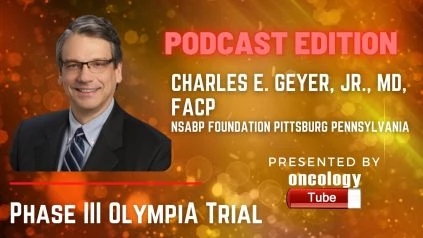Charles E. Geyer, Jr., MD, FACP, Principal Investigator for NSABP B-55 Portion of the OlympiA Trial, Medical Oncologist & Breast Cancer Specialist, Chief Scientific Officer, NSABP Foundation Pittsburg Pennsylvania. In this video, he speaks about Adjuvant Olaparib for Patients with BRCA1- or BRCA2-Mutated Breast Cancer.
Â
Abstract –
Origins:
Poly(adenosine diphosphate–ribose) polymerase inhibitors use synthetic lethality to target tumors with deficiencies in homologous recombination repair. To minimize recurrence in patients with BRCA1 or BRCA2 germline mutation–associated early breast cancer, new medicines are required.
Â
Methodologies:
Patients with human epidermal growth factor receptor 2 (HER2)–negative early breast cancer, BRCA1 or BRCA2 germline pathogenic or likely pathogenic variants, and high-risk clinicopathological factors who had received local treatment and neoadjuvant or adjuvant chemotherapy were enrolled in a phase 3 double-blind, randomized trial. Patients were randomly randomized (in a 1:1 ratio) to receive either oral olaparib or a placebo for one year. Invasive disease–free survival was the primary end objective.
Â
Findings:
A total of 1836 patients were randomly assigned. In a prespecified event-driven interim analysis with a median follow-up of 2.5 years, the olaparib group had a 3-year invasive disease–free survival rate of 85.9 percent versus 77.1 percent in the placebo group (difference, 8.8 percentage points; 95 percent CI, 4.5 to 13.0; hazard ratio for invasive disease or death, 0.58; 99.5 percent CI, 0.41 to 0.82; P0.001). The olaparib group had 87.5 percent distant disease–free survival compared to 80.4 percent in the placebo group (difference, 7.1 percentage points; 95 percent CI, 3.0 to 11.1; hazard ratio for distant disease or death, 0.57; 99.5 percent CI, 0.39 to 0.83; P0.001). Olaparib was associated with fewer fatalities than placebo (59 and 86, respectively) (hazard ratio, 0.68; 99 percent CI, 0.44 to 1.05; P=0.02), but the between-group difference was not significant at an interim-analysis boundary of less than 0.01. The safety findings were consistent with olaparib’s known side effects, with no extra major adverse events or adverse events of special interest.
Â
Observations:
Adjuvant olaparib after completion of local treatment and neoadjuvant or adjuvant chemotherapy was associated with significantly longer survival free of invasive or distant disease than placebo in patients with high-risk, HER2-negative early breast cancer and germline BRCA1 or BRCA2 pathogenic or likely pathogenic variants. Olaparib had just a minor impact on overall patient-reported quality of life. (Funded by the National Cancer Institute and AstraZeneca; NCT02032823 for OlympiA; opens in new tab.)

